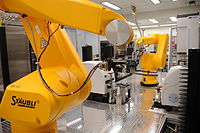
Photo from wikipedia
The genetic information and functional properties of plants have been further identified with the completion of the whole-genome sequencing of numerous crop species and the rapid development of high-throughput phenotyping… Click to show full abstract
The genetic information and functional properties of plants have been further identified with the completion of the whole-genome sequencing of numerous crop species and the rapid development of high-throughput phenotyping technologies, laying a suitable foundation for advanced precision agriculture and enhanced genetic gains. Collecting phenotypic data from dicotyledonous crops in the field has been identified as a key factor in the collection of large-scale phenotypic data of crops. On the one hand, dicotyledonous plants account for 4/5 of all angiosperm species and play a critical role in agriculture. However, their morphology is complex, and an abundance of dicot phenotypic information is available, which is critical for the analysis of high-throughput phenotypic data in the field. As a result, the focus of this paper is on the major advancements in ground-based, air-based, and space-based field phenotyping platforms over the last few decades and the research progress in the high-throughput phenotyping of dicotyledonous field crop plants in terms of morphological indicators, physiological and biochemical indicators, biotic/abiotic stress indicators, and yield indicators. Finally, the future development of dicots in the field is explored from the perspectives of identifying new unified phenotypic criteria, developing a high-performance infrastructure platform, creating a phenotypic big data knowledge map, and merging the data with those of multiomic techniques.
Journal Title: Frontiers in Plant Science
Year Published: 2022
Link to full text (if available)
Share on Social Media: Sign Up to like & get
recommendations!